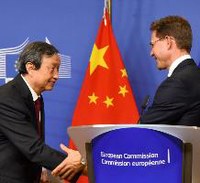(BRUSSELS) – The EU and China held their 6th annual EU-China High-level Economic and Trade Dialogue in Brussels Tuesday with steel over-capacity and market access at the top of their agenda.
Participating Commissioners and ministers discussed a range of strategic issues under the theme “Strengthening Policy Coordination, Promoting Sustainable Growth”. Topics included macro-economic challenges, global economic governance and ongoing reforms in China and the EU. Bilateral issues included negotiations on investment, questions related to overcapacity in the steel sector and how to manage bilateral trade frictions in compliance with WTO rules.
The meeting was co-chaired by Commission vice-president Jyrki Katainen and Chinese Vice-Premier Ma Kai.
Production overcapacity in the steel sector featured highly. Both sides followed up on the last Summit’s agreement to establish a dedicated bilateral platform on steel and the Global Forum set up at the G20 summit in Hangzhou. A first meeting of the EU-China platform on steel overcapacity is due shortly.
China has committed to make its steel industry more responsive to market forces, and to reduce its excess production capacity and to ensure that its policies and support do not target the net expansion of steel capacity. Vice-President Katainen called on China to activate urgently all relevant policy tools to address the trade-related aspects of steel overcapacity.
China and the EU further committed to make operational the Global Steel Forum on Excess Capacity, which was announced at the G20 Summit in Hangzhou in September. In this Forum, all G20 and interested OECD economies – including China and the EU – will not only enhance communication and cooperation, but also take effective steps to address overcapacity. The EU welcomes China’s efforts to finalise discussions on the basis of the facilitating role by the OECD.
The EU and China also agreed to continue the dialogue on overcapacity, avoid the emergence of new barriers and future overcapacity in advanced industrial sectors.
On trade and market access, the EU continues to urge significantly improved market access for EU companies as well as a level playing field for business and investment. The EU handed over a list of the key concerns on market access and encouraged China to provide a list of their key concerns. The EU and China agreed to work together on addressing structural market access problems to ensure that the key barriers affecting both sides are eliminated.
The EU pushed to conclude negotiations on an agreement on Geographical Indications in the first half of 2017. The Chinese side reconfirmed its commitment to conclude the negotiations as soon as possible and both sides will meet shortly to that effect.
Regarding the digital economy, the EU and China agreed to explore further how to boost sustainable economic and societal development in line with the strategies for the Digital Single Market for Europe and Digital China. Both sides noted partial progress made in the implementation of the Joint Declaration on EU-China strategic cooperation in the field of 5G and support the extension of Chinese and European enterprises’ reciprocal participation in scientific research and innovation programmes.
The EU is China’s biggest trading partner, while China is the EU’s second largest trading partner after the United States. Trade in goods between the EU and China is worth well over 1.5 billion a day, with EU exports amounting to 170 billion and imports to 350 billion in 2015.
The EU continues to be a top recipient of Chinese investment. There are indications that transactions could reach 27 billion in 2016, which would mean a growth of around 33% year-on-year. In the meantime, EU Foreign Direct Investment to China continues to drop as it remains below 1.8 billion for the fourth quarter in a row.



